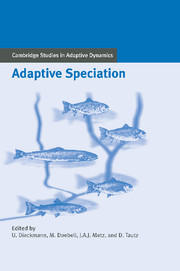Book contents
- Frontmatter
- Contents
- Contributing Authors
- Acknowledgments
- Notational Standards
- 1 Introduction
- 2 Speciation in Historical Perspective
- A Theories of Speciation
- B Ecological Mechanisms of Speciation
- 8 Speciation and Radiation in African Haplochromine Cichlids
- 9 Natural Selection and Ecological Speciation in Sticklebacks
- 10 Adaptive Speciation in Northern Freshwater Fishes
- 11 Sympatric Speciation in Insects
- 12 Adaptive Speciation in Agricultural Pests
- 13 Ecological Speciation in Flowering Plants
- 14 Experiments on Adaptation and Divergence in Bacterial Populations
- C Patterns of Speciation
- References
- Index
10 - Adaptive Speciation in Northern Freshwater Fishes
Published online by Cambridge University Press: 05 July 2014
- Frontmatter
- Contents
- Contributing Authors
- Acknowledgments
- Notational Standards
- 1 Introduction
- 2 Speciation in Historical Perspective
- A Theories of Speciation
- B Ecological Mechanisms of Speciation
- 8 Speciation and Radiation in African Haplochromine Cichlids
- 9 Natural Selection and Ecological Speciation in Sticklebacks
- 10 Adaptive Speciation in Northern Freshwater Fishes
- 11 Sympatric Speciation in Insects
- 12 Adaptive Speciation in Agricultural Pests
- 13 Ecological Speciation in Flowering Plants
- 14 Experiments on Adaptation and Divergence in Bacterial Populations
- C Patterns of Speciation
- References
- Index
Summary
Introduction
Fish constitute the most species-rich group of the vertebrates. They have adapted to highly diverse habitats in the sea and fresh waters of the world and display great phenotypic variability. Some fish groups have gone through extremely rapid local radiations with clear connections to ecological factors. Such extensive radiations are, for example, seen in various groups of cichlids in the African rift lakes (e.g., Echelle and Kornfield 1984; Meyer 1993; van Alphen et al. in Chapter 8). Radiations in those vast lakes have been termed intralacustrine, which emphasizes that the relevant speciation events in the monophyletic species flocks are not necessarily sympatric (Smith and Todd 1984; Meyer 1993). A convincing case for sympatric speciation is seen in studies of cichlids in Cameroon crater lakes (Schliewen et al. 1994). In many cases, the evolution of diversity is seen to occur within populations of what are still considered single species, in which so-called varieties or morphs have emerged as a result of adapting to different habitats and food resources (e.g., Robinson and Wilson 1994; Skúlason and Smith 1995; Smith and Skúlason 1996). From a purely ecological perspective, these phenomena can be viewed as resource polymorphisms (Skúlason and Smith 1995). From an evolutionary perspective, they can be seen as multiple instances of incipient speciation. Thus, resource polymorphisms provide important opportunities to study the role of ecological factors in the evolution of new species (Schluter 1996b, 1998, 2001).
- Type
- Chapter
- Information
- Adaptive Speciation , pp. 210 - 228Publisher: Cambridge University PressPrint publication year: 2004
- 55
- Cited by



